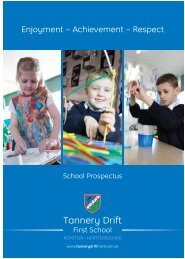Ofsted Report 2011 - Tannery Drift First School
Ofsted Report 2011 - Tannery Drift First School
Ofsted Report 2011 - Tannery Drift First School
- No tags were found...
You also want an ePaper? Increase the reach of your titles
YUMPU automatically turns print PDFs into web optimized ePapers that Google loves.
Inspection report: <strong>Tannery</strong> <strong>Drift</strong> <strong>School</strong>, 7–8 February <strong>2011</strong> 4 of 15<br />
Inspection grades: 1 is outstanding, 2 is good, 3 is satisfactory, and 4 is inadequate<br />
Please turn to the glossary for a description of the grades and inspection terms<br />
Inspection judgements<br />
Overall effectiveness: how good is the school 2<br />
The school’s capacity for sustained improvement 2<br />
Main findings<br />
<strong>Tannery</strong> <strong>Drift</strong> is a good school. In spite of a number of temporary changes in school<br />
leadership, it has successfully maintained the momentum for school improvement.<br />
These efforts have resulted in significant improvements in the Early Years Foundation<br />
Stage, provision for special educational needs and/or disabilities and continuing<br />
strengths in its range of extra-curricular activities, especially in sports.<br />
The successful Early Years Foundation Stage ensures children make a good start to<br />
their education. Pupils go on to make good progress, to reach above-average<br />
standards at the end of Year 2, and are well prepared for their transition to middle<br />
school by the end of Year 4. Pupils with special educational needs and/or disabilities<br />
make particularly good progress to reach standards above similar pupils nationally.<br />
All parents and carers who responded say that their children are secure in school.<br />
Pupils readily agree that they feel very safe and well supported. They respond well to<br />
the opportunities for reflection in assemblies and are considerate and cooperative in<br />
their relationships with others. Behaviour is good in lessons and around the school<br />
because staff successfully manage and support a small number of pupils who find it<br />
difficult to concentrate. This ensures effective learning because pupils know that any<br />
upsets and concerns are quickly addressed. Pupils’ healthy eating and exceptionally<br />
high participation in sports and physical activities reflect, in many cases, exemplary<br />
healthy lifestyles. Pupils are actively involved in the school council as well as the<br />
house system, where many contribute to the school programme supporting pupils’<br />
social and emotional development. Others also take a lead on ecological concerns<br />
and participate in well-regarded music and drama events in the local community.<br />
Pupils’ overall spiritual, moral, social and cultural development is good, enhanced by<br />
well-planned multi-cultural activities such as ‘One World Week,’ where pupils<br />
celebrate cultural difference.<br />
Teaching is good, particularly in terms of personal relationships and classroom<br />
practice. Lessons engage pupils’ interest and the varied activities, and particularly<br />
good additional learning support, enable pupils with different needs and abilities to<br />
make good progress. However, marking and assessment practice is variable in the<br />
detail and guidance it provides to help pupils improve their work, particularly in terms<br />
of National Curriculum levels.<br />
The curriculum is strong in a number ways, including developing literacy and<br />
numeracy both discretely and within other subject areas. Physical education and





